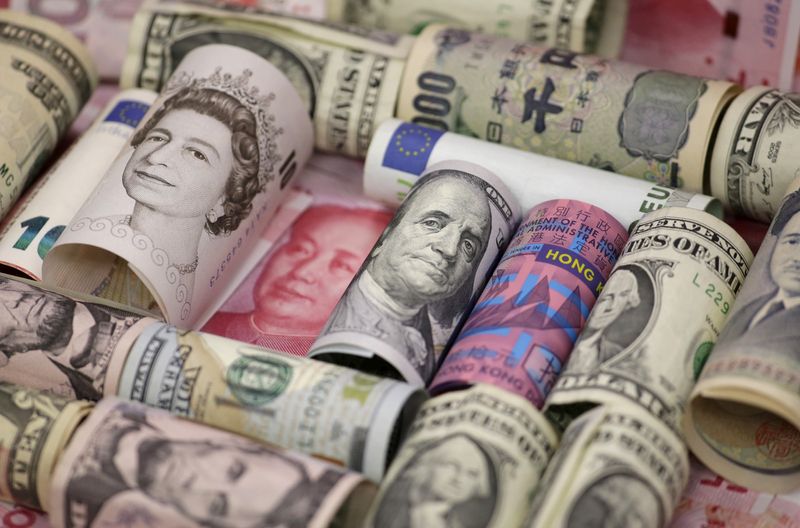Forex
US dollar slips after inflation data, Fed meeting looms next week


© Reuters. Euro, Hong Kong dollar, U.S. dollar, Japanese yen, British pound and Chinese 100-yuan banknotes are seen in a picture illustration shot January 21, 2016. REUTERS/Jason Lee/Illustration/File Photo
By Gertrude Chavez-Dreyfuss
NEW YORK (Reuters) -The U.S. dollar inched lower on Friday, after data showed inflation rose modestly in December but was trending lower, which should keep the Federal Reserve on track to cut interest rates by the middle of the year.
Volume faded in the afternoon ahead of the weekend and as investors braced next week for a slew of important U.S. economic data such as non-farm payrolls for January and key events led by the Federal Open Market Committee meeting and the Treasury’s refunding announcement. The latter will outline the U.S. government’s borrowing requirements for the upcoming quarter.
On the week, the greenback was on track to post gains for four straight weeks. The was last down 0.1% at 103.41.
Data showed the personal consumption expenditures (PCE) price index increased 0.2% last month after an unrevised 0.1% drop in November. In the 12 months through December, the PCE price index increased 2.6%, matching November’s unrevised gain. Those numbers were in line with consensus expectations.
The annual inflation rate was under 3% for the third straight month. The Fed tracks the PCE price measure for its 2% inflation target.
“We continue to see pieces of data that suggest at this moment the market shouldn’t be concerned about rising inflation in any signficant and immediate capacity,” said Jeff Klingelhofer, co-head of investments at Thornburg Investment Management in Santa Fe, New Mexico.
“That takes further tightening off the table because what the Fed has acknowledged a number of times and continued to point to is that as inflation falls and as their policy rate doesn’t move, then the tightness of monetary policy actually increases,” he added.
Currency analysts at MUFG said in a note that U.S. economic data presented a mixed picture for monetary policy, ahead of the Fed’s next policy statement on Jan. 31.
“…the strong end to the year must surely place further doubt on the scope for the Fed to commence its easing cycle by March. But March still remains feasible primarily due to the very favourable inflation data within the GDP report,” the note said.
Post-inflation data, U.S. rate futures market priced in a roughly 47% chance of easing at the March meeting, down from late Thursday’s 51% probability, and the 80% chance factored in two weeks ago, according to LSEG’s rate probability app.
The market is fully pricing in the first rate cut to occur at the May meeting, with a roughly 90% probability, down slightly from late Thursday, which was at 94%. About five rate cuts of 25 basis points each have been priced in this year.
Jonathan Petersen, senior markets economist at Capital Economics wrote in a research note that despite recent solid economic data, growing disinflationary pressures have kept a lid on Treasury yields and the dollar.
Much like the Fed, he noted that other central banks such as the European Central Bank, have pushed back against market expectations of rates cuts in the next couple of months.
“Against this backdrop, our view remains that there isn’t a lot of scope for a much stronger dollar over the coming quarters,” Petersen said.
In other currency pairs, the greenback rose 0.3% versus the yen to 148.06 . The dollar, however, was down 0.3 for the week, on pace for its largest weekly decline since Dec. 25.
The euro was up 0.1% at $1.0856, rebounding from a six-week low hit earlier in the session after a survey showed weaker-than-expected German consumer sentiment.
ECB policymaker Martins Kazaks also said on Friday the central bank was on the right path to lower inflation but patience was required before policy can be reversed.
The euro was down 0.7% for the week, its worst weekly performance since October. Sterling was last slightly down against the dollar at $1.2702, ahead of a Bank of England decision on interest rates next Thursday.

 Forex3 years ago
Forex3 years agoForex Today: the dollar is gaining strength amid gloomy sentiment at the start of the Fed’s week

 Forex3 years ago
Forex3 years agoUnbiased review of Pocket Option broker

 Forex3 years ago
Forex3 years agoDollar to pound sterling exchange rate today: Pound plummeted to its lowest since 1985

 Forex3 years ago
Forex3 years agoHow is the Australian dollar doing today?

 Cryptocurrency3 years ago
Cryptocurrency3 years agoWhat happened in the crypto market – current events today

 World3 years ago
World3 years agoWhy are modern video games an art form?

 Commodities3 years ago
Commodities3 years agoCopper continues to fall in price on expectations of lower demand in China

 Economy3 years ago
Economy3 years agoCrude oil tankers double in price due to EU anti-Russian sanctions





















